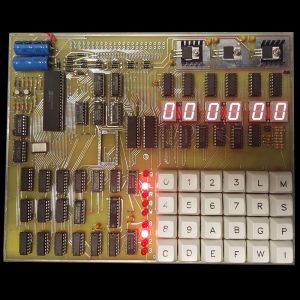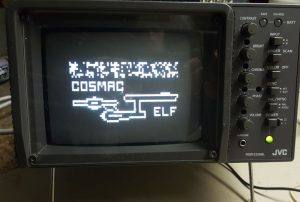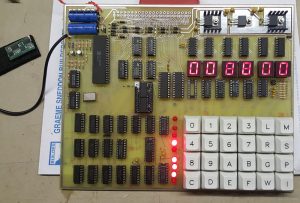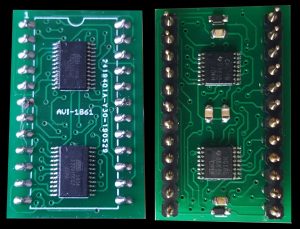
Super Elf
Posted by musovern on Apr 15th, 2018 in Cosmac-Elf, Single Board Computers | 0 comments
The SuperElf single-board computer was made by Quest Electronics. It was an improvement of the Netronics Elf and Elf II training boards, also based on the RCA 1802, one of the first RISC microprocessors.
The board also featured an 1861 video chip that was closely tied to the 1802 to generate a video image of 128×64 dots.
2, 4 or 6 7-segment Led display could be used. Its hexadecimal keyboard allowed programs to be entered and controlled more efficiently thanks to 8 function keys:
I – Input
L – Load mode
R – Reset
G – Go (run mode)
W – Wait (processor clock could be stopped)
M – enable Monitor ROM
S – Single step
P – Protect memory
The main board had connections for a speaker (and a circuit to drive the speaker). Sound was entirely software driven as the hardware simply had a single digital output bit (Q) tied to an LED and also to the speaker.
An optional expansion board could be added, providing serial port (software driven), cassette interface (also software driven), 1 KB ROM monitor, optional 2K tiny basic, 4 KB RAM. 2 S-100 slots where additional static memory or a video board could be used. Along with a Super Monitor, there where two versions of pitman’s tiny basic, one that used the 1861 video chip and another that used a 64 characters x16lines s-100 video board.
The cassette’s output used the same ‘Q’ output used for audio on the main board, which meant that you heard all of your data as it was written out to cassette.
The 9 LEDs along the left side of the keypad indicate the state of the ‘Q’ output, the current operating mode (Load, Reset, Run, Wait) as well as the current state of the CPU (Fetch, Execute, DMA, Interrupt).
NAME SuperElf
MANUFACTURER RCA
TYPE Home Computer
ORIGIN U.S.A.
YEAR 1978
BUILT IN LANGUAGE Hexadecimal Monitor
KEYBOARD 24 keys with 8 function keys
CPU RCA 1802
SPEED 1.79 MHz
COPROCESSOR 1861 video chip
RAM 128 bytes
ROM Unknown
TEXT MODES 2 to 6 7-segment Led display
COLORS Red!
SOUND Primitive sound generator
SIZE / WEIGHT Unknown
I/O PORTS External power transformer, optional expansion connector
BUILT IN MEDIA tape recorder
POWER SUPPLY Power regulation on board
PERIPHERALS 4 KB RAM card, S-100 bus
PRICE $106.95 (with 256 bytes RAM)
The Starship program running

The 1861 video chip substitute.

Next is to install the simple monitor PROM ic and test the system.

The Pixie 1861 chip replacement PCB board i made.
Leave a Reply